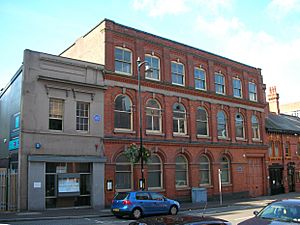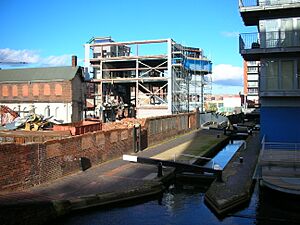Elkington Silver Electroplating Works facts for kids
The Elkington Silver Electroplating Works was a very important building in Birmingham, England. It was located on Newhall Street. This building was once a busy factory where a special process called electroplating happened. Later, it became home to the Museum of Science and Industry. This science museum eventually moved to a new place called Thinktank.
The original factory was built in 1838 by George Elkington. He was famous for inventing and perfecting electroplating. This process uses electricity to put a thin layer of metal, like silver, onto other objects. Imagine making a spoon look shiny and silver without it being solid silver! The factory was quite large and had many workshops. It even stretched over the Birmingham and Fazeley Canal. In the 1850s, the factory used an early steam-powered electric generator. This machine helped with the electroplating process.
Today, you can find two special blue plaques on the building's wall. One plaque honors George Elkington himself. The other celebrates his employee, Alexander Parkes. Alexander Parkes is famous for inventing the very first plastic!
Contents
Birmingham's Science Museum Home
This historic building became the science museum for Birmingham Museum & Art Gallery in 1951. It was a place where people could learn about science and technology. The museum stayed there until it closed its doors in 1997. Many of its amazing exhibits then moved to a new, modern science museum called Thinktank. Thinktank opened in Millennium Point in September 2001.
The Powerful Smethwick Engine
One of the most famous exhibits that moved was the Smethwick Engine. This incredible steam engine was built way back in 1797 by the famous inventor James Watt. It was originally used in the town of Smethwick. Later, it was moved to the museum in 1959. It's a fantastic example of early industrial power!
The First Industrial Generator
Another important item moved to Thinktank was Elkington's own Woolrich Electrical Generator. This machine was made in 1844. It was one of the earliest electrical generators ever used in a factory. It showed how electricity could power industrial processes.
What Happened to the Building?
After the science museum moved out, the Birmingham City Council decided to redevelop the site. This area is located along Newhall Street and Charlotte Street, right next to the Birmingham and Fazeley Canal. In 2002, a company called St Bernard's Property was chosen for the project.
In 2006, plans were approved for a new development called the Jewellery Box. This project included shops, businesses, and 234 apartments. Construction began in 2008. More apartments were added in 2019. The site is also next to the beautiful grade II listed Queen's Arms pub. This whole area is part of the historic Jewellery Quarter Conservation Area.
See also



